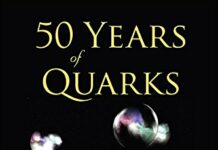
Ebook Info
- Published: 2010
- Number of pages: 464 pages
- Format: PDF
- File Size: 83.06 MB
- Authors: Harald Fritzsch
Description
Murray Gell-Mann is one of the leading physicists of the world. He was awarded the Nobel Prize in Physics in 1969 for his work on the classification and symmetries of elementary particles, including the approximate SU(3) symmetry of hadrons. His list of publications is impressive; a number of his papers have become landmarks in physics. In 1953, Gell-Mann introduced the strangeness quantum number, conserved by the strong and electromagnetic interactions but not by the weak interaction. In 1954 he and F E Low proposed what was later called the renormalization group. In 1958 he and R P Feynman wrote an important article on the V-A theory of the weak interaction. In 1961 and 1962 he described his ideas about the SU(3) symmetry of hadrons and its violation, leading to the prediction of the Ω- particle. In 1964 he proposed the quark picture of hadrons. In 1971 he and H Fritzsch proposed the exactly conserved “color” quantum number and in 1972 they discussed what they later called quantum chromodynamics (QCD), the gauge theory of color. These major publications and many others are collected in this volume, providing physicists with easy access to much of Gell-Mann’s work. Some of the articles are concerned with his recollections of the history of elementary particle physics in the third quarter of the twentieth century.
User’s Reviews
Editorial Reviews: From the Back Cover Murray Gell-Mann is one of the leading physicists in the world. He was awarded the Nobel Prize in Physics in 1969 for his work on the SU(3) symmetry. His list of publications, albeit relatively short, is highly impressive he has written mainly papers, which have become landmarks in physics. In 1953, Gell-Mann introduced the strangeness quantum number. In 1954, he proposed, together with F Low, the idea of the renormalization group. In 1958, Gell-Mann wrote, together with R Feynman, an important paper on the V-A theory of weak interactions. In 1961, Gell-Mann published his ideas on the SU(3) symmetry. In 1964, he proposed the quark model for hadrons. In 1971, Gell-Mann, together with H Fritzsch, proposed the color quantum number; and in 1972, the theory of QCD. These major publications of Gell-Mann are collected in this volume, thus providing physicists with easy access to the important publications of Gell-Mann.
Reviews from Amazon users which were colected at the time this book was published on the website:
⭐Murray Gell-Mann received the Nobel Prize in 1969. Deep research did not prevent him to write for a large pubilc, for instance The Quark and the Jaguar. Here, we have a series of scientific papers, mainly of research level (Symmetries of baryons and mesons, for instance), sometimes of philosophical bearing (The garden of live flowers).Unless you are yourself a physics professional, or at least of graduate mathematics level, don’t buy this book. Or accept to find the treasure you look for in some pages in English among dozens of others in formulas.
⭐Murray Gell-Mann passed away 24 May 2019. Physicist John Preskill wrote: “He contributed so many deep ideas that drove the field forward, many of which are just as relevant today.” The editor of these papers, Harold Fritzsch, writes: “Murray-Gell Mann has contributed more than anybody else to the theoretical understanding of elementary particles” and “who became regarded by some as Albert Einstein’s scientific successor.” (pages vii and 26, respectively). If those statements are taken at face-value, then one need look no further for a reason to peruse these papers.Unfortunately, an average non-professional, non- physicist, reader will struggle in placing those remarks in context of this comparatively slim volume (as compared to World Scientific’s Selected Papers of Richard Feynman, or Julian Schwinger). Here are 31 reprinted papers, most are technical–a few are not. The editor, in an initial 23 pages, provides a brief commentary for each paper. I found it difficult to comprehend how Murray Gell-Mann arrived at the results he did arrive at (that is, his thought-processing are not altogether transparent). Be that as it may, I let Gell-Mann speak:(1) “it is important not only to situate scientific ideas in the context of their own time but also to try to figure out what relation the scientists’ thinking bore to what we now know to be correct, how close they came to the right answers, or why they missed them.” (1980, Particle Theory, From S-matrix to Quarks).(2) “It may be that a new approach to the rest-masses of elementary particles can solve many of our present theoretical problems.” (1964, The Eightfold Way).(3) “If quantum mechanics is the underlying framework of the laws of physics, then there must be a description of the Universe as a whole– and everything in it–in quantum mechanical terms.” (1989, Quantum Mechanics in the Light of Quantum Cosmology).(4) “Life can perfectly well emerge from the laws of physics plus accidents, and mind from neurobiology.” (1992, Nature Conformable to Herself).(5) “The founders of quantum mechanics were right in pointing out that something external to the framework of wave-function and Schrodinger equation is needed to interpret the theory.” (2007, Quasiclassical Coarse Graining and Thermodynamic Entropy).(6) “In our work, we are always between Scylla and Charybdis; we may fail to abstract enough, or we may abstract too much and end up with fictitious objects in our models turning into real monsters that devour us.” (1972, Quarks).Concluding: My hardcover edition is sturdy and well-produced with high-quality, glossy, paper.These are challenging papers. In the nontechnical essay recalling Richard Feynman (1989, Physics Today) Gell-Mann writes: “I have always personally preferred the operator approach” and “we drifted apart to a considerable extent.” In perusing these papers by Gell-Mann, it is easy to see why those two physicists would have “drifted apart.”
Keywords
Free Download Murray Gell-Mann: Selected Papers (World Scientific 20th Century Physics) 1st Edition in PDF format
Murray Gell-Mann: Selected Papers (World Scientific 20th Century Physics) 1st Edition PDF Free Download
Download Murray Gell-Mann: Selected Papers (World Scientific 20th Century Physics) 1st Edition 2010 PDF Free
Murray Gell-Mann: Selected Papers (World Scientific 20th Century Physics) 1st Edition 2010 PDF Free Download
Download Murray Gell-Mann: Selected Papers (World Scientific 20th Century Physics) 1st Edition PDF
Free Download Ebook Murray Gell-Mann: Selected Papers (World Scientific 20th Century Physics) 1st Edition




